[Retracted] Two-Stage Research on AC/DC Hybrid High-Voltage Distribution Network Based on Network Reconfiguration and SOP Coordinated Control
Abstract
DC power grid has the advantages of large power supply capacity, easy access to clean energy, low loss, and easy power control. With the increasing penetration rate of distributed generation and DC load in low-voltage transmission network, the traditional radial AC distribution form develops into AC-DC hybrid form. Large-scale distributed energy access is an important feature of future distribution system. Aiming at the AC-DC hybrid distribution system with soft tie-in switch and voltage source converter, considering the network congestion caused by large-scale access of distributed energy, a two-stage congestion management mechanism is proposed. This strategy solves the congestion problem of AC/DC hybrid transmission network with the help of the power flow control ability of AC/DC transmission network’s own optimization control means and congestion management services provided by distributed energy sources. According to the experiment, the total distributed generation power of DC link is 15 MW, and the load power is 10 MW, that is, the remaining power of DC link is 5 MW, the total distributed generation power of AC link is 8 MW, and the load power is 15 MW, that is, the power shortage of AC link is 7 MW. In the first stage, the tie-in switch, SOP and VSC are coordinated and optimized, and in the second stage, the flexible adjustment ability provided by distributed energy makes up for the deficiency of the adjustment ability of direct control means in some periods of severe congestion and meets the requirements of congestion management of AC-DC hybrid transmission network under high-permeability distributed generation.
1. Introduction
The high penetration and decentralized access of distributed renewable energy and the rapid increase of new loads such as electric vehicles will make the distribution system face strong uncertainty of source and load. Some urban transmission networks will be more prone to network security problems due to the limitation of line transmission capacity. The rapid growth of urban scale leads to the increasing power supply radius of urban transmission network, which makes the traditional power grid face the problems of increased line loss and voltage fluctuation [1]. At the same time, the increasingly tense corridors of power supply lines also put forward higher requirements for the transmission capacity of the lines [2]. In the traditional AC system, in order to limit the system within the safe boundary, the system operator must divert and select the optimal power supply path through the switching operations such as moving, replacing, and load shedding. However, a large number of standby lines are planned and built in the urban high-voltage transmission network, and there are many alternative paths for switching operations. Moreover, because the switching operations of regional dispatchers mostly focus on the local congestion that is occurring and cannot fully consider the optimal overall operation state, the switching operations are often frequent and large-scale, with many operations and high control costs.
With the increasing penetration rate of distributed generation and DC load in low-voltage transmission network, the traditional radial AC distribution mode has developed to the AC-DC hybrid mode [3]. AC-DC hybrid power distribution combines the advantages of DC power distribution and AC power distribution and has obvious advantages in power supply efficiency, reliability, and flexibility. The randomness and volatility of distributed generation in AC/DC hybrid distribution system have a serious impact on the safe and stable operation of transmission network and power quality. Local transmission congestion is one of the most common security problems in the network. When the output of high-proportion connected renewable energy cannot be absorbed locally, a large amount of surplus power will flow to the remote load point through the power grid, making the transmission power of some transmission lines larger than their maximum transmission capacity, resulting in network congestion [4]. There are many kinds of equipment in AC/DC transmission network, and the grid-connected characteristics of different equipment are very different, which puts forward new requirements for the coordinated control of multiple converter stations in transmission network. The uncertainty of new energy sources and the difference of power flow calculation between AC and DC systems bring new challenges to the optimal operation and dispatch of AC and DC transmission networks [5, 6].
In order to better solve the congestion problem of transmission network, this paper proposes a two-stage congestion management mechanism based on SOP and VSC for AC/DC hybrid transmission network. This strategy solves the congestion problem of AC/DC hybrid transmission network by means of the power flow control ability of AC/DC transmission network’s own optimized control means and congestion management services provided by distributed energy sources. In the first stage, considering the optimization and regulation ability of SOP, VSC, and tie-in switch which can directly control resources in AC/DC hybrid transmission network, a multiresource coordinated optimization scheduling model is established. In the second stage, considering the limitation of regulating ability of direct control resources, using flexible resources such as new energy power stations, electric vehicle charging stations, and adjustable loads, the congestion management control model is established with the lowest cost of distribution company as the optimization objective. Each grid-connected converter works in droop control mode according to the upper scheduling instruction, so that the system works in an optimized state when it is stable. When there is a bad working condition, the control strategy of switching the interconnected converter and the energy storage unit converter is adopted to maintain the DC voltage stability of the transmission network. In a long time scale, the corresponding optimization objectives are established for the normal operation of the system and the DC disconnection fault, and the scheduling instructions are provided for the lower layer through the optimized scheduling algorithm. The simulation results verify the effectiveness of the proposed control strategy.
1.1. Chapter Arrangement of This Paper
The first section of this paper introduces the extension research of AC/DC hybrid high-voltage transmission network by related scholars, the second section analyzes the topology of transmission network based on SOP, the third section makes experimental analysis on the effect of AC/DC hybrid high-voltage transmission network based on two-stage congestion management architecture, and the fourth section is the full-text summary.
1.2. The Innovation of This Paper
This paper proposes a two-stage congestion management mechanism for AC/DC hybrid distribution network with SOP and VSC, which makes full use of the power flow optimization ability of direct control means of distribution network and the flexible adjustment ability of distributed energy to effectively solve the network congestion problem.
2. Related Work
The main purpose of energy management of low-voltage AC-DC hybrid transmission network is to ensure the safe and stable operation of the transmission network, reduce the operation cost of the transmission network as much as possible, and improve the utilization rate of renewable energy. According to the grid structure of low-voltage AC-DC hybrid transmission network, it can be seen that energy management strategies include regional power distribution strategies and energy storage charging and discharging management strategies. In order to realize the energy management strategy, the real-time energy management system is also a very important part of energy management [7].
Khan et al. divided AC/DC hybrid transmission network into AC transmission network area and DC transmission network area and proposed a hierarchical distributed multisource coordinated optimal scheduling system, including local scheduling layer and regional scheduling layer. The local scheduling layer only optimizes the interior of the region and then reports the optimization results to the regional scheduling layer. The regional scheduling layer coordinates the regional output from the global perspective [8]. Gao et al. put forward a flexible and reliable construction scheme of active transmission network. In this scheme, AC/DC hybrid connection, plug and play, high power quality construction, flexible DC loop closure, and other technologies are adopted to build a flexible and reliable active transmission network, and the comprehensive utilization of energy in Suzhou is realized through the coordinated optimal dispatch of source, load, and storage [9]. Li et al. proposed a flexible DC interconnection scheme for multimicrogrids and established an optimization model with the aim of minimizing the fluctuation of bus voltage in microgrids and the loss of the system. This method effectively suppresses the fluctuation of bus voltage and improves the permeability of renewable energy [10]. When Li and Zhang set up the optimization model, they considered the commutation loss caused by the power interaction between AC and DC, which improved the economy of the whole transmission network. From the previous literature, it can be seen that the load peak-valley difference among regions can be reduced by coordinating the distribution of power among regions. Reduce electric energy conversion links, reduce commutation losses, and improve the economy of transmission network operation. An adaptive control method with variable threshold is proposed, which uses adaptive intelligent technology to control the charging and discharging power of stored energy, improves the distribution efficiency of electric energy, and realizes peak shifting and valley filling [11]. Fang et al. established the optimal dispatching model of AC/DC active transmission network based on the second-order cone programming. The model takes the minimum sum of power purchase cost and penalty cost of light and wind abandonment as the optimization objective and realizes the combined optimal dispatching of AC/DC active transmission network through measures such as active and reactive power regulation of distributed power, switching of capacitive reactance, charging and discharging of energy storage, reactive power regulation of voltage source converter, and dynamic reconfiguration of transmission network [12]. Ling et al. introduced the fuzzy stochastic optimization theory into the optimal operation of microgrid and solved the problem that the randomness and volatility of renewable energy have a great deviation to the daily dispatch [13]. Liu et al. proposed a two-stage real-time energy management strategy for the uncertainty of microgrid. First, the internal electricity price response mechanism was established according to the internal supply and demand relationship of microgrid, and with the minimum total cost of system operation as the optimization objective, real-time online dynamic optimization was completed based on MPC [14]. Dolatabadi et al. designed a microgrid energy management system based on ARM, including equipment layer, management layer, and optimization layer, which can realize local data monitoring and remote monitoring and scheduling. However, there is no research on real-time energy management strategy in this document, and the real-time performance of the system needs to be further verified [15]. Zhang et al. designed the hardware and software of the node controller for AC/DC hybrid microgrid. The hardware consists of ARM, DSP, and CPLD and provides multichannel digital input and output interfaces. The energy management system has rich hardware interfaces, fast data operation speed, and good anti-interference performance, which provides a hardware platform for the implementation of energy management strategies. However, the system cannot store a large amount of data, and it is very difficult to analyze the data in the later stage [16]. On the basis of studying the energy management strategy of energy storage system, Qu et al. put forward the mixed programming method of MAT and C#, which effectively combined the energy management strategy with the real-time energy management system, and provided the foundation for the implementation of the energy management strategy. However, this document only carried out simulation and did not carry out experimental verification in combination with the actual environment [17]. Wu et al. put forward an adaptive control method with variable threshold, which uses adaptive intelligent technology to control the charging and discharging power of stored energy, improves the distribution efficiency of electric energy, and realizes peak shifting and valley filling [18].
Because the congestion management of traditional AC high-voltage distribution network relies on traditional means such as switching power supply and switching power supply, and the scale is often huge, the improvement of model and algorithm cannot well meet the demand of rapid power adjustment caused by the strong fluctuation of distributed generation and the time-space transfer characteristics of new loads such as electric vehicles. Aiming at the above problems, this paper carries out congestion management based on network reconfiguration and SOP coordinated control technology.
3. Grid Structure Design of AC/DC Hybrid Transmission Network
3.1. Characteristics of Operation Form of High-Voltage Transmission Network Based on SOP
In the low-voltage AC-DC hybrid transmission network, because the power electronic devices are connected with the access of distributed power, the whole transmission network presents a high degree of power electronization, the loss of the converter becomes a nonnegligible part of energy management, and the control methods of the converter are flexible and diverse [19]. Traditional high-voltage transmission network generally refers to 110 kV transmission network, which consists of large-capacity transformers, long-distance transmission lines, capacitive cables, reactive power compensation devices, in-station circuit breakers and isolation breakers, and high-voltage buses for electric energy gathering and voltage monitoring. Some distributed power sources may be connected to the grid at this voltage level. Its topological structure is generally a multiring radial structure with extensive development, as shown in Figure 1.
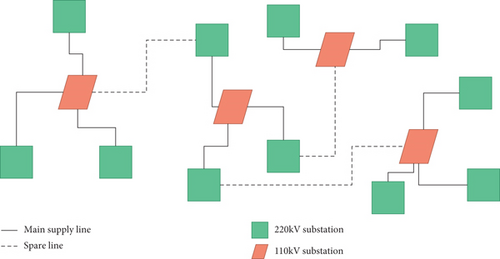
Compared with the medium-voltage transmission network, its characteristics can be summarized as nondeep structure and abundant interstation communication: the nondeep structure means that the number of parallel load points along the line from the substation to a certain power supply terminal is small, which is because the load distribution of high-voltage transmission network is scattered and its capacity is large, and it is easier to cause the terminal voltage to be low when the deep network is adopted. There are abundant interstation connections, that is, there are many power supply paths or standby lines between 110 kV substation and other 110 kV substations and upper substations, and there are many combinations of main and standby power supply paths between stations. This is because the high-voltage distribution network is the connection link between the transmission network and the medium-voltage distribution network, which requires high reliability. This structural feature also makes the feasible solution space of the optimal model of reconstruction and supply transfer huge, and the optimal route of supply transfer is related to the wiring in the station and its operation mode, so it causes great difficulties to solve the optimal route.
Generally, a trunk road extending from one upper power supply node to another power supply node contains at most two or three 110 kV substations, which should be separated by circuit breakers to ensure that the electromagnetic loop of 220 kV-110 kV-220 kV cannot be formed, and each 110 kV substation has at least one or two backup lines connected to another 110 kV substation to ensure reliability. The equivalent treatment methods under different control modes of VSC are shown in Table 1.
| Active power control method | Reactive power control method | Ac equivalent node | Side DC equivalent node |
|---|---|---|---|
| Constant active power control | Constant reactive power control | QP node | U node |
| Constant DC voltage control | Constant reactive power control | OS node | P node |
| DC voltage droop control | Constant reactive power control | PA node | P node |
In chain transmission network, each load can only get electric energy through a single path. Chain DC transmission network has simple structure and low requirements for protection system and simple operation. However, in the chain transmission network, if the medium voltage bus or AC/DC converter fails, all the load power supply in the transmission network will be affected, and even a large area of power failure will occur [20]. Therefore, the power supply reliability of chain structure is low. In AC/DC hybrid transmission network, VSC converter station plays the role of AC/DC subnetwork energy exchange and maintaining system voltage stability, and the coordinated control strategy among multiple converter stations is the premise of safe and efficient operation of the whole system. The coordinated control strategies of multiconverter stations mainly include master-slave control, DC voltage deviation control, and sag control.
All new loads and distributed power sources are connected to AC lines, among which new DC loads and photovoltaic cells need to be connected to the inverter through DC transformers, wind turbines need rectifiers and inverters to be connected to the grid, and new AC loads need to be connected to the grid through AC transformers. If the interconnected converter is controlled by constant active power, the optimization variable is the input and output power reference value of the interconnected converter. If that DC bus voltage is control, the optimization variable is the reference value of the corresponding DC bus voltage. In case of DC voltage droop control, the optimization variable can choose the input and output power reference value of interconnected converter or the corresponding DC bus voltage reference value. The principle of master-slave control in normal operation is shown in Figure 2.

In the figure, the dashed boxes indicate the operating range of the converter station, and the solid dots are the current operating points. The master-slave controller will take one converter station in the transmission network as the master converter station and other converter stations as the slave converter stations. The main converter station is controlled by constant DC voltage, which controls the DC voltage output by its port to maintain the stability of the whole subnet bus voltage. The slave converter station adopts constant active power control. Data exchange is realized between the converter stations through the communication system. When the main converter station fails, a group of slave converter stations will receive more information instructions and switch to constant DC voltage control. All converter stations in the transmission network have equal status, adopt the same control mode, and share the DC voltage offset of the system.
Ring distribution network connects the distribution network into a ring network based on the two-end power supply structure. When any line fails, the connected bus can rely on the power supply of other lines to ensure the normal operation of the connected load, so it has the highest power supply reliability. Considering the congestion management mechanism of AC/DC hybrid transmission network based on SOP and VSC, there are two stages. In the first stage, the congestion problem is solved at a lower cost by directly controlling the adjustment ability of resources. In this stage, distributed flexible resources operate according to their own power generation plans or electricity demand, which avoids the impact of congestion on users and improves the service quality of the system. In the second stage, when the line congestion is serious, it is not enough to completely solve the congestion by directly controlling the resources through the transmission network. At this time, it is considered to mobilize distributed flexible resources to participate in congestion management, send regulation signals to each distributed energy source, and each distributed energy source responds to the regulation signals and uploads its congestion management quotation to the transmission network management center. Based on the quotation, the transmission network management center establishes a congestion management control model with minimum cost and sends regulation instructions to each distributed flexible resource. The corresponding parameters and initial iteration values of each DC node are shown in Table 2.
| Node type | Variable corresponding to node type | DC node actual distribution active power | Sagging coefficient |
|---|---|---|---|
| P node | 0 | Psec | Uxdp |
| Q node | 3 | Pxdp | 1.0pu |
| P-Q node | 1 | -Pk | 1.0pu |
In order to keep the radial network structure, the transmission network is generally designed in closed loop and operated in open loop. Closed-loop structure is to facilitate power supply transfer in case of failure and improve the reliability of power supply in operation. Open-loop operation can effectively limit the short-circuit fault current, protect the devices on the line, and prevent the circuit breaker from exploding. On the other hand, it is to control the fault spread and prevent a large-scale power outage.
When any line in an AC unit fails, within the power supply capacity of DC link, DC link can supply power to the load in the nonfault section of the line through the corresponding VSC. Because VSC can isolate AC/DC faults, the normal operation of another normal AC line and DC link will not be affected by the fault.
3.2. Topology Analysis of Transmission Network
First, this paper gives the mathematical model of transmission network reconfiguration, including the objective function of reconfiguration and various constraints. The new data storage structure of transmission network is adopted, which is convenient to solve the reconfiguration problem. Loop division is selected to improve the coding mode, and the method of identifying infeasible solutions is given. At the same time, the greedy strategy is introduced, the cuckoo algorithm is improved by adopting adaptive step size and discovery probability, and the application flow of the algorithm for network reconfiguration is given. Finally, the improved cuckoo algorithm is applied to two transmission network examples, and the feasibility, efficiency, and accuracy of the algorithm are verified.
The installation of SOP basically does not change the original topology, and only the cause contact switch can be replaced. However, since SOP can control the transmission power of the line where it is located, the adjustment path of back-to-back VSC can be dynamically established by reconfiguring the switches of high-voltage transmission network to control the injection or outflow of active power and reactive power. In order to verify the effectiveness of the algorithm for transmission network reconfiguration, an example of IEEE33-bus distribution system is analyzed in this paper. The topology of the distribution system includes 38 nodes and 42 branches, including 2 power nodes and 6 connecting branches. The reference power is 100MVA, the rated voltage is 12.66 kV, the active load of the nodes is 3824 kW, and the reactive load is 2170kVar. Programming in Matlab R2013a environment can get the reconstruction results as shown in Figure 3.
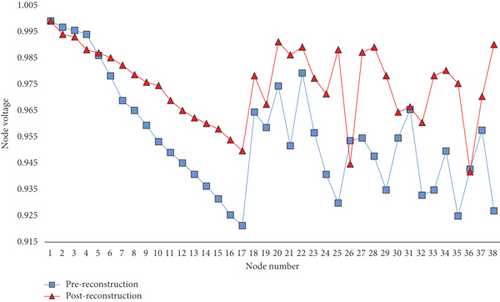
The main purpose of the lower optimization model is to distribute the power among different areas in a coordinated way. By controlling the transmission power of interconnected converters, the bus voltage connected to interconnected converters, and selecting the reference point for secondary regulation of interconnected converters, the fluctuation of distributed generation has the smallest impact on the transmission network. Distributed generation is an important part of AC/DC transmission network. This paper introduces the characteristics of common wind turbines in distributed generation. Considering the uncertainty of wind speed in nature, in order to use wind energy safely and effectively, fans are generally equipped with gearboxes, monitoring, and protection. There are many random variables in the optimization algorithm, which leads to strong uncertainty in every execution of the algorithm. It is difficult to explain the advantages and disadvantages of the algorithm only by running a program once. In order to verify the efficiency of this algorithm, it is compared with the single cuckoo algorithm and the traditional particle swarm optimization algorithm. The three algorithms are run 30 times each, and the convergence curves of PSO, CS, and improved CS algorithms are drawn by taking the average of the reconstructed results, as shown in Figure 4.
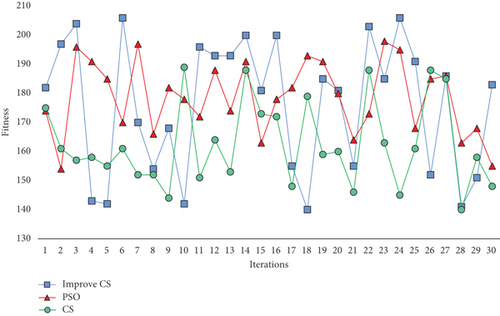
In AC/DC hybrid transmission network, the characteristics of DC system without inductive reactance and capacitive reactance make voltage the only index to measure the power balance of DC network. Converter station level control plays a vital role in maintaining DC power balance and voltage stability. Master-slave control means that the main converter station adopts constant DC voltage control to ensure the power stability of the whole DC system, and the rest converter stations adopt constant power control. This method requires high communication between stations, and once the main converter station fails, the system will face the danger of collapse. Voltage margin control can be regarded as the improvement of master-slave control. This method does not rely on interstation communication and has strong regulating ability, but it has DC voltage deviation. Alternating iteration method takes coupling variables as the global iteration object to calculate the power flow of AC system and DC system, respectively, so this method has strong applicability for AC/DC distribution systems with different port numbers.
4. Two-Stage Congestion Management Architecture of AC/DC Hybrid Transmission Network
4.1. Two-Stage Congestion Management Architecture
The adjustable resources in AC/DC hybrid transmission network include the resources that can be directly controlled by distribution companies such as contact switch, SOP, and VSC, as well as distributed flexible resources such as new energy power stations, electric vehicle charging stations, and adjustable load aggregators. Among these two kinds of resources, the first kind of resources is called direct control resources, which belong to power grid assets, and the regulation cost of these resources is very low. Constraints include system power flow balance constraint and system operation constraint, in which system power flow balance constraint includes AC power balance constraint and DC power balance constraint, and system operation constraint includes node voltage constraint, AC line power flow constraint, DC line power flow constraint, network topology constraint, and SOP and VSC operation constraint.
In the congestion management of transmission network, direct control resources are the priority of regulation resources. Distributed flexible resources, such as new energy power stations and electric vehicle charging stations, generally operate according to their output plans or charging requirements, and it takes a high cost to regulate them. Therefore, they are used as the second-stage candidate regulation scheme when the priority regulation resources cannot eliminate the network congestion. DC line is transformed from AC line, and AC line and DC line are connected by VSC. In order to fully consider the impact of distributed power generation, three wind turbines with a capacity of 350 kW and four photovoltaic power generation systems with a capacity of 360 kW are added in the example, with power factors of 0.8. The daily load and distributed power output are shown in Figure 5.
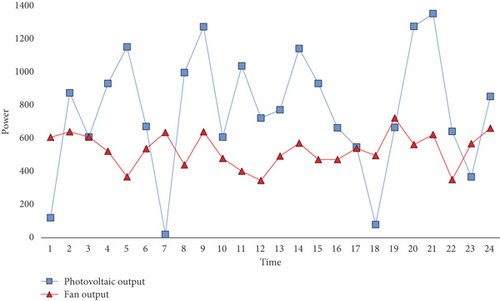
Network reconfiguration reduces the loss by changing the topology of the system, and its loss reduction ability is limited. SOP and VSC can realize the precise control of the active power transmission between lines and provide certain voltage and reactive power support, thus realizing the economical and efficient operation of the system. Due to the strong randomness and volatility of distributed generation’s output, its first-stage output forecasting accuracy is low, so it is necessary to revise the current dispatching plan in a short time according to the ultrashort-term forecasting information, so as to ensure the safe operation of the distribution network.
4.2. Analysis of Optimization Effect
The optimal dispatching model of AC/DC hybrid transmission network optimizes VSC and SOP of tie switches at the same time. The optimized variables include both discrete variables and continuous variables. This paper adopts the mixed integer second-order cone programming method to solve it. In the second stage, the congestion management control model is solved by the second-order cone programming method. After the second-order cone transformation of the model, it is directly solved by using mature commercial software. The proposed mathematical model is programmed by MATLAB, and different results are compared by different optimization schemes, as shown in Figure 6.
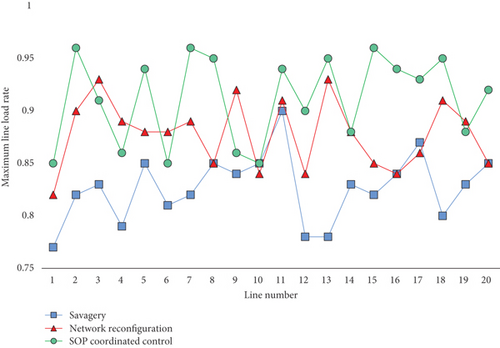
It can be seen from the figure that using the diversity of high-voltage transmission network operation modes to dynamically construct SOP connection path greatly improves SOP power flow regulation ability and effectively alleviates congestion. The simulation results show that the proposed method can effectively reduce the maximum line load rate and node load rate, make the power flow distribution more balanced, leave enough margin in each part of the network, and improve the security level of the system operation. High-voltage transmission network reconfiguration is a coarse-grained discrete power flow transfer strategy, which is difficult to meet different local network constraints at the same time, resulting in unnecessary load shedding. However, with the fine-grained control capability of SOP’s continuous refinement, it can make up for the error caused by discrete supply transfer, effectively reduce the load loss, and greatly reduce the control cost, as shown in Figure 7.
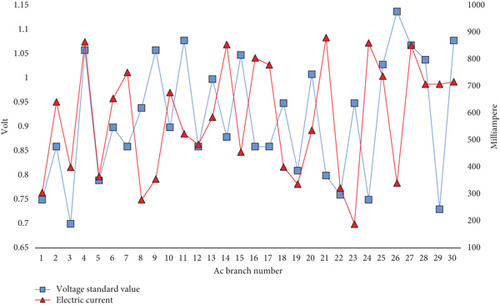
In the first stage, the coordination and optimization of tie-in switch, SOP, and VSC effectively enhanced the absorptive capacity of transmission network for renewable energy, reduced the impact on users’ electricity consumption, and reduced the congestion management adjustment cost. In the second stage, the flexible adjustment ability provided by distributed energy makes up for the deficiency of adjustment ability of direct control means in some severe congestion periods, reduces the risk of line power flow exceeding the limit, and meets the requirements of congestion management of AC/DC hybrid transmission network under high permeability distributed power. The total distributed generation power of DC link is 15 MW, and the load power is 10 MW, that is, the remaining power of DC link is 5 MW, the total distributed generation power of AC link is 8 MW, and the load power is 15 MW, that is, the power shortage of AC link is 7 MW. In practice, when the load is heavy and the line is long, the voltage of all nodes may not be adjusted to the normal level only by reactive power compensation at the end of the line. At this time, it is necessary to take additional appropriate reactive power compensation measures at the nodes with too low voltage. The analysis shows that after the transformation of AC-DC hybrid transmission network, providing certain reactive power compensation to AC lines through VSC can effectively reduce the input of reactive power compensation equipment and improve the power supply quality of AC lines.
5. Conclusions
In order to describe the loss characteristics of the converter more accurately, based on the steady-state model of the converter, the loss model of VSC is approximately represented by nonlinear function, and the loss model of DC/DC converter is approximately represented by equivalent resistance. By analyzing the control characteristics and external characteristics of the converter, the equivalent treatment methods of different control modes in energy management are given. The structure of AC-DC hybrid transmission network proposed in this paper is theoretically correct and feasible. The DC link can not only ensure the DC load and the grid connection of distributed power but also provide appropriate reactive power compensation to AC lines, thus improving the supply voltage and quality of AC lines. The reconfiguration of high-voltage transmission network is a coarse-grained discrete power flow transfer strategy, which is difficult to meet different local network constraints at the same time, resulting in unnecessary load shedding. However, with the fine-grained control capability of SOP’s continuous refinement, it can make up for the error caused by discrete supply transfer, effectively reduce the load loss, and greatly reduce the control cost. In the positive sequence component control system, generally speaking, the limiting link is included in the outer loop power controller, and the current limiting control is realized by giving a current command, which effectively avoids the overcurrent problem of VSC.
In this paper, when optimizing the operation of AC/DC system, only a single-objective optimization model is established, and many indicators such as wind abandonment rate, new energy subsidy, and equipment depreciation cost need to be considered in actual dispatching. Based on this, the next work can establish a multiobjective optimization model of AC/DC distribution network.
Conflicts of Interest
The authors declare no conflicts of interest.
Open Research
Data Availability
The dataset can be accessed upon request.




